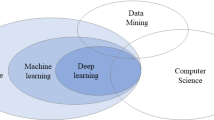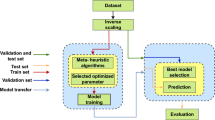Abstract
Since the mechanical behaviour of rock masses is influenced by the shear behaviour of their discontinuities, analytical models are being developed to describe the shear behaviour of rock discontinuities. The aim of this paper is to present a model to predict the shear behaviour of clean rock discontinuities developed by using artificial neural networks (ANN), as an alternative to the existing analytical models which sometimes require certain parameters obtained from large-scale laboratory tests which are not always available. Results from direct shear tests on different boundary conditions and types of discontinuities have been used to develop this ANN model, whose input parameters contain the boundary normal stiffness, the initial normal stress, the joint roughness coefficient, the compressive strength of the intact rock, the basic friction angle and the horizontal displacement of a joint. This proposed ANN model fits the experimental data better than some existing analytical models, and it can satisfactorily describe how governing parameters influence the shear behaviour of clean rock discontinuities. This paper also presents a practical application where the proposed ANN model is used to analyse the stability of a rock slope.














Similar content being viewed by others
References
Barton N (1973) Review of a new strength criterion for soft rocks. Eng Geol 7:287–332
Barton N, Bandis S (1990) Review of predictive capabilities of JRC-JCS model in engineering practice. In: Barton N, Stephansson O (eds) Proceedings of international symposium on rock joints, Loen, Norway. Balkema, Rotterdam, pp 603–610
Barton N, Choubey V (1977) The shear strength of rock joints in theory and practice. Rock Mech 10:1–54
Beale MH, Hagan MT, Demuth HB (2010) Neural network. MathWorks Toolbox™ 7—User’s Guide
Benmokrane B, Ballivy G (1989) Laboratory study of shear behaviour of rock joints under constant normal stiffness conditions. In: Khair (ed) Rock mechanics as a guide of efficient utilization of natural resources. Balkema Publishers, Rotterdam, pp 899–906
Boslaugh S (2012) Statistics in a nutshell, 2nd edn. O’Reilly Media, Sebastopol
Dantas Neto SA, Silveira MV, Amâncio LB, Anjos GM (2014) Pile settlement modeling with multilayer perceptrons. Electron J Geotech Eng 19:4517–4528. http://www.ejge.com/2014/Ppr2014.426ma.pdf
Dantas Neto SA, Silveira MV, Anjos GM, Moura AS (2016) Settlement prediction model for continuous flight auger, steel and bored piles using artificial neural networks. Revista Geotecnia 136:27–48
Dehghan S, Sattari G, Chelgani CS, Aliabadi MA (2010) Prediction of uniaxial compressive strength and modulus of elasticity for Travertine samples using regression and artificial neural networks. Min Sci Technol 20:0041–0046
Feng X, Katsuyama K, Wang Y, Lin Y (1997) A new direction—intelligent rock mechanics and rock engineering. Int J Rock Mech Min Sci 34(1):135–141
Haykin S (2009) Neural networks and learning machines, 3rd edn. Prentice Hall International Inc, Upper Saddle River
Indraratna B, Haque A (2000) Shear behaviour of rock joint. Balkema, Rotterdam, p 164
Indraratna B, Haque A, Aziz A (1998) Laboratory modelling of shear behaviour of soft joints under constant normal stiffness condition. J Geotech Geol Eng 16:17–44
Indraratna B, Haque A, Aziz A (1999) Shear behaviour of idealised infilled joints under constant normal stiffness. Géotechnique 49(3):331–355
Indraratna B, Welideniya H, Brown E (2005) A shear strength model for idealised infilled joints under constant normal stiffness. Géotechnique 55(3):215–226
Indraratna B, Jayanathan M, Brown E (2008) Shear strength model for overconsolidated clay-infilled idealised rock joints. Géotechnique 58(1):55–65
Indraratna B, Oliveira DAF, Brown ET (2010a) A shear-displacement criterion for soil-infilled rock discontinuities. Géotechnique 60(8):623–633
Indraratna B, Oliveira DAF, Brown ET, Assis AP (2010b) Effect of soil-infilled joints on the stability of rock wedges formed in a tunnel roof. Int J Rock Mech Min Sci 47(5):739–751
Indraratna B, Thirukumaran S, Brown ET, Zhu S (2015) Modelling the shear behaviour of rock joints with asperity damage under constant normal stiffness. Rock Mech Rock Eng 48:179–195. doi:10.1007/s00603-014-0556-2
Khandelwal M, Singh TN (2006) Prediction of blast induced ground vibration and frequency in opencast mine: a neural network approach. J Sound Vib 289:711–725
Ladanyi B, Archambault G (1970) Simulation of shear behaviour of a jointed rock mass. In: Proceedings of 11th symposium on rock mechanics, Urbana, Illinois, pp 105–125
McCulloch WS, Pitts W (1943) A logical calculus of the ideas immanent in nervous activity. Bull Math Biophys 5:115–133
Meulenkamp F, Grima MA (1999) Application of neural networks for the prediction of the unconfined compressive strength (UCS) from Equotip hardness. Int J Rock Mech Min Sci 36:29–39
Monjezi M, Dehghani H (2008) Evaluation of effect of blasting pattern parameters on back break using neural networks. Int J Rock Mech Min Sci 45:1446–1453
Nejad FP, Jaksa MB, McCabe BA (2009) Prediction of pile settlement using artificial neural networks based on standard penetration test data. Comput Geotech 36(7):1125–1133
Oliveira D, Indraratna B (2010) Comparison between models of rock discontinuity strength and deformation. J Geotech Geoenviron Eng 136(6):864–874
Papaliangas T, Hencher SR, Manolopoulos S (1993) The effect of frictional fill thickness on the shear strength of rock discontinuities. Int J Rock Mech Min Sci Geomech 30(2):81–91
Patton FD (1966) Multiple modes of shear failure in rocks. In: Proceedings of 1st congress of ISRM, Lisbon, Portugal, pp 509–513
Rumelhart DE, Hinton GE, Williams RJ (1986) Learning representations by back-propagating errors. Nature 323:533–536
Sayadi A, Monjezi B, Talebi N, Khandelwal M (2013) A comparative study on the application of various artificial neural networks to simultaneous prediction of rock fragmentation and backbreak. J Rock Mech Geotech Eng 5:318–324
Schmidhuber J (2015) Deep learning in neural network: an overview. Neural Netw 61:85–117. doi:10.1016/j.neunet.2014.09.003
Seidel JP, Haberfield CM (1995) The application of energy principles to the determination of the sliding resistance of rock joints. Rock Mech Rock Eng 28(4):211–226
Singh VK, Singh D, Singha TN (2001) Prediction of strength properties of some schistose rocks from petrographic properties using artificial neural networks. Int J Rock Mech Min Sci 38:269–284
Skinas CA, Bandis SC, Demiris CA (1990) Experimental investigations and modelling of rock joint behaviour under constant stiffness. In: Barton, Stephanson (eds) Rock joints. Balkema Publisher, Rotterdam, pp 301–307
Sonmez H, Gokceouglu C, Nefesliogh HA, Kayabasi A (2006) Estimation of rock modulus: for intact rock with an artificial neural network and for rock masses with a new empirical equation. Int J Rock Mech Min Sci 43:224–235
Sonmez H, Ercanoglu M, Kalender A, Dagdelenler G, Tunusluogly R (2016) Predicting uniaxial compressive strength and deformation modulus of volcanic bimrocks considering engineering dimension. Int J Rock Mech Min Sci 86:91–103
Tiryaki B (2008) Application of neural network for predicting the cuttability of rocks by drag tools. Tunn Undergr Space 23:273–280
Widrow B, Hoff ME (1960) Adaptive switching circuits. IRE WESCON Convention Record, Los Angels, California, USA, pp 96–104
Yılmaz I, Yuksek AG (2008) An example of artificial neural network (ANN) application for indirect estimation of rock parameters. Rock Mech Rock Eng 41(5):781–795
Zang Q, Song J, Nie X (1991) Application of neural network model to rock mechanics and rock engineering. Int J Rock Mech Min Sci 38(6):535–540
Acknowledgments
The authors wish to thank the CNPq (National Research Council of Brazil) for financially supporting the research that led to this work, which is part of a postdoctoral research, and also the University of Wollongong, Australia.
Author information
Authors and Affiliations
Corresponding author
Rights and permissions
About this article
Cite this article
Dantas Neto, S.A., Indraratna, B., Oliveira, D.A.F. et al. Modelling the Shear Behaviour of Clean Rock Discontinuities Using Artificial Neural Networks. Rock Mech Rock Eng 50, 1817–1831 (2017). https://doi.org/10.1007/s00603-017-1197-z
Received:
Accepted:
Published:
Issue Date:
DOI: https://doi.org/10.1007/s00603-017-1197-z




